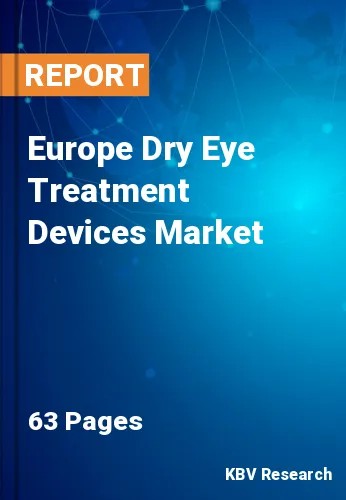The Europe Dry Eye Treatment Devices Market would witness market growth of 6.9% CAGR during the forecast period (2022-2028).
Wetting less than 5 mm, with or without anesthetic, is regarded as diagnostic for dry eyes in this test. A Schirmer II test can be used to detect reflex secretion if Schirmer's test results are abnormal. This test involves irritating the nasal mucosa with a cotton-tipped applicator and then measuring tear production with Whatman #41 filter paper. Wetting less than 15 mm after five minutes is deemed abnormal for this test. The length of time it takes for tears to separate in the eye is measured using a tear breakup time (TBUT) test. A drop of fluorescein can be injected into the cul-de-sac to measure the tear breakup time.
The amount of lysozyme present in tears is determined using a test for tear protein analysis. Lysozyme makes up between 20 and 40% of the total protein in tears. A good correlation between tests is provided by a lactoferrin analysis test. Different ocular dryness states have abnormally high concentrations of the recently found tear molecule Ap4A. Using a simple Schirmer test and a tear sample, this molecule can be measured biochemically.
It is possible to use this method to find the Ap4A concentrations in patients' tears and so assess scientifically if the samples are symptomatic of dry eye. A diagnostic for a dry eye condition called the tear osmolarity test has been suggested. In comparison to corneal and conjunctival staining, tear break-up time, the Schirmer test, and meibomian gland grading, tear osmolarity may be a more accurate way to diagnose and grade the severity of dry eye.
Patients in Europe with dry eye syndrome range in age and gender. Other than a modern lifestyle, factors that are anticipated to drive the dry eye treatment devices market in Europe include an aging population, a rise in health-conscious consumers, an increase in allergies among Europeans, and an increasing prevalence of digital devices, such as tablets and smartphones, which are continuing to increase eye irritation.
The Germany market dominated the Europe Dry Eye Treatment Devices Market by Country in 2021; thereby, achieving a market value of $22.9 million by 2028. The UK market is exhibiting a CAGR of 6.1% during (2022 - 2028). Additionally, The France market would showcase a CAGR of 7.7% during (2022 - 2028).
Based on Technology, the market is segmented into Meibomian Gland Expression (MGX), Broadband light (BBL), Intense Pulsed Light (IPL) and Combination (MGX+IPL). Based on End User, the market is segmented into Ophthalmic Clinics, Hospitals and Others. Based on countries, the market is segmented into Germany, UK, France, Russia, Spain, Italy, and Rest of Europe.
Free Valuable Insights: The Global Dry Eye Treatment Devices Market will Hit $348.8 Million by 2028, at a CAGR of 7.4%
The market research report covers the analysis of key stake holders of the market. Key companies profiled in the report include MiBo Medical Group, Sight Sciences, Inc., Lumenis Ltd., ESW Vision SAS, Johnson & Johnson Vision Care, Inc. and Alcon, Inc.
By Technology
By End User
By Country
Our team of dedicated experts can provide you with attractive expansion opportunities for your business.

